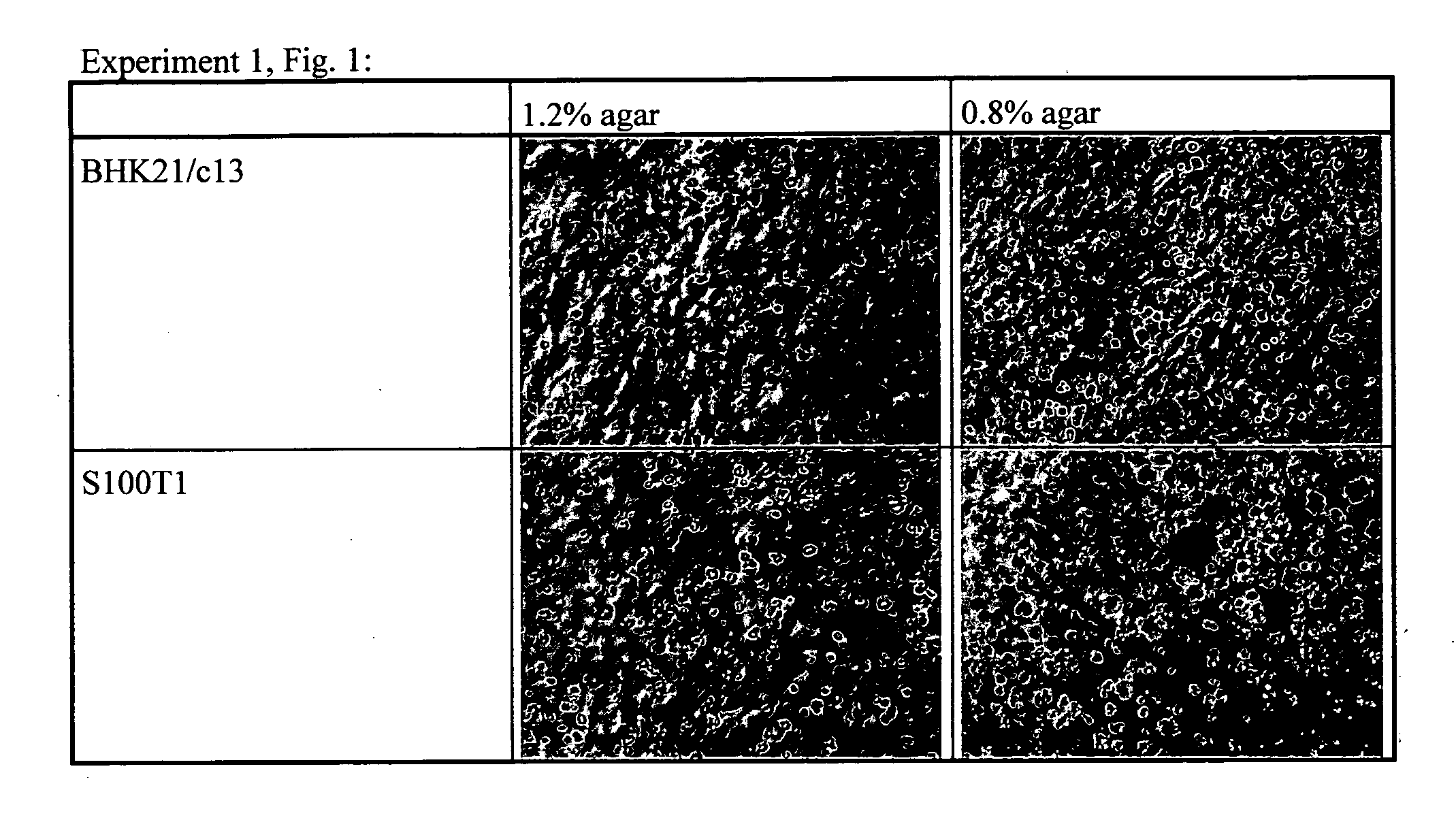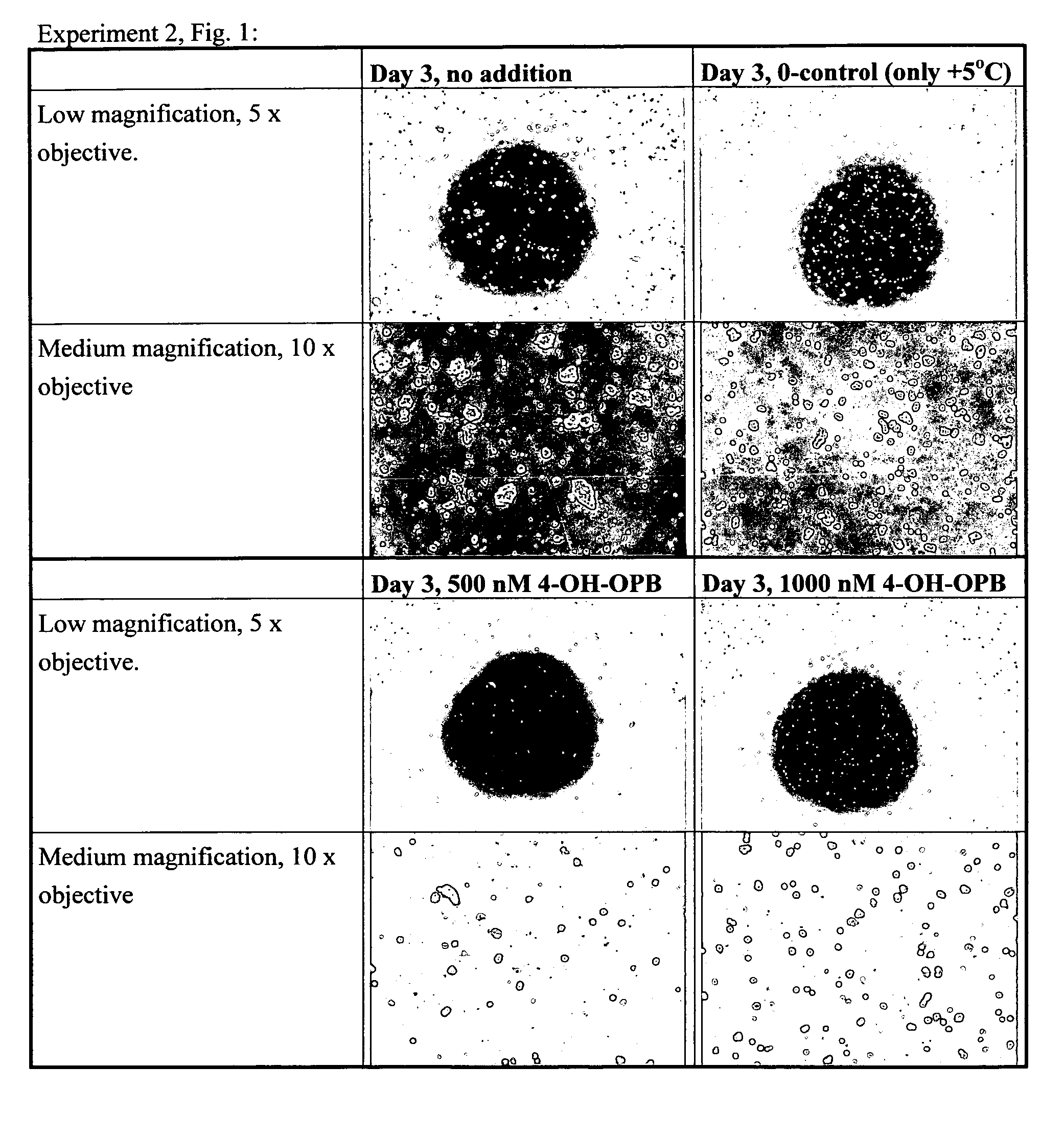Method for selection of compounds which inhibit clonal cell growth and use thereof
a clonal cell and compound technology, applied in the direction of plant growth regulators, biocide, biochemistry apparatus and processes, etc., can solve the problems of drug, drug, drug effect, drug effect, etc., to reduce or abrogate the inhibition of cloning
- Summary
- Abstract
- Description
- Claims
- Application Information
AI Technical Summary
Benefits of technology
Problems solved by technology
Method used
Image
Examples
experiment 14
The Effect of Cell Density on Clonal Growth of MT4 Cells Inhibited by 4-OH-OPB.
Question:
[0445] 1. Is there a cell density below which no cell growth will take place?[0446] 2. Will 4-OH-OPB act differently on clonal growth in low-density cultures compared to high-density cultures?
[0447] Set-up: Cross dilution of cells (MT4 grown on Gibco foetal bovine serum, Cat. No. 10106-169, Lot No. 40F5426F) and 4-OH-OPB (Syntagon):
TABLE 1Growth the second day:4-OH—OPB*10−−−3−−+1−++0.3−++0.1−++0−−−+++Cells / well5 cells50 cells500500050000500000 cellscellscellscells
*Final concentration in μM
[0448] Ten fold cell dilutions indicatet in the last row (Table 1) were undertaken in Falcon tissue culture tray using 6×6 wells.
[0449] The 4-OH-OPB dilutions were prepared minutes before being used from 20 mM stock solution in DMSO.
[0450] The 10 μM and 3 μM dilutions were made first and each of them were diluted further in 1 / 10 steps.
Conclusion:
[0451] The answer of the first question: “Is there a ce...
experiment 15
Screening Non-Steroid Anti-Inflammatory Drugs (NSAIDs) or Other Potential Drugs for Anti-Clonal Effect Using Polyoma Virus Transformed BHK21 / c13 Cells, the S100T1 Line, Growing in Soft Agar Medium.
[0460] Question: Are there substances other than 4-OH-OPB that have anticlonal activity? Will they be found among mitotic inhibitors, NSAIDs or common painkillers (Table 1)?
TABLE 1Table showing the examples that were included in this study:Name, Sigma catalogueAmountVol.Nono.synonymMWweighedDMSO14-OH—OPBAV-1101340.45.00.7342ColchicineColchicine399.43.30.4133Diphenylhydantoin,Fenantoin252.35.51.090D40074Podophyllotoxin P4405414.44.80.5795Piroxicam P5654Piroxicam331.48.81.3286Diclofenak D6899Voltaren318.14.00.6297Ibuprofen I 4883Brufen206.33.10.7518Naproxen M 4015Naprosyn230.33.60.7829Acetylsalicylic acid AAspirin180.24.91.360537610Control
[0461]
TABLE 2Dilutions and average dose:HumanμM in20 mMName, Sigma cataloguedose,20dilutedAmountμM inNono.MWmglitres*#to wellwellsDilutions14-OH—OPB340....
experiment 16
Testing Drugs or Potential Drugs for Anti-Clonal Effect Using Polyoma Virus Transformed BHK21 / c13 Cells, the Clone S100T1, Growing in Soft Agar.
[0478] Question: Are there other substances than 4-OH-OPB that might have anticlonal activity? Will they be found among inhibitors of mitosis or NSAIDs or common painkillers (Table 1)? What about Colchicine that tested positive before? The test became negative last time. Also the other that tested positive using high concentrations should be tested again.
[0479] Experiment 16
TABLE 1Name, SigmaAmountVol.Nocatalogue no.synonymMWweighedDMSO 1#Colchicine, C-9754,Colchicine399.43.30.413Lot 60K1932 2*Colchicine, C-9754,Colchicine399.42.10.263Lot 60K1932 3, 4*Colchicine, C-9754,Colchicine399.43.20.401Lot 28H1229. 5#Podophyllotoxin414.44.80.579P4405, Lot 12K1562 6, 7*Podophyllotoxin414.42.40.290P4405, Lot 12K1562 8*Ibuprofen I 4883,Brufen206.33.10.751Lot 26H1386 9*Naproxen M 4015,Naprosyn230.33.60.782Lot 111K199110*Acetylsalicylic acid AAspirin1...
PUM
| Property | Measurement | Unit |
|---|---|---|
| Volume | aaaaa | aaaaa |
| Volume | aaaaa | aaaaa |
| Volume | aaaaa | aaaaa |
Abstract
Description
Claims
Application Information
 Login to View More
Login to View More - R&D
- Intellectual Property
- Life Sciences
- Materials
- Tech Scout
- Unparalleled Data Quality
- Higher Quality Content
- 60% Fewer Hallucinations
Browse by: Latest US Patents, China's latest patents, Technical Efficacy Thesaurus, Application Domain, Technology Topic, Popular Technical Reports.
© 2025 PatSnap. All rights reserved.Legal|Privacy policy|Modern Slavery Act Transparency Statement|Sitemap|About US| Contact US: help@patsnap.com



